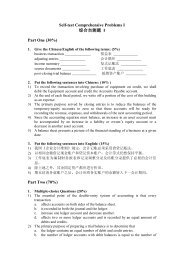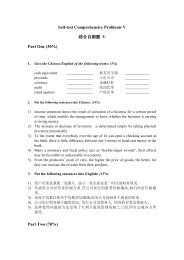Vodafone Group Plc Annual Report for the year ended 31 March 2012
Vodafone Group Plc Annual Report for the year ended 31 March 2012
Vodafone Group Plc Annual Report for the year ended 31 March 2012
You also want an ePaper? Increase the reach of your titles
YUMPU automatically turns print PDFs into web optimized ePapers that Google loves.
<strong>Vodafone</strong> <strong>Group</strong> <strong>Plc</strong><br />
<strong>Annual</strong> <strong>Report</strong> <strong>2012</strong><br />
Industry trends<br />
18<br />
Where <strong>the</strong><br />
industry is now<br />
The mobile industry is a large and important sector with<br />
six billion global users. Customer growth over <strong>the</strong> last five<br />
<strong>year</strong>s has been rapid, driven by <strong>the</strong> benefits of mobility,<br />
falling prices and rising penetration in emerging markets.<br />
However, pressures on revenue growth from competition<br />
and regulation are significant and are likely to remain.<br />
aa<br />
86% of <strong>the</strong> world’s population use a mobile phone<br />
aa<br />
Competition is intense with typically at least four mobile operators in each<br />
country and numerous additional alternative communications providers<br />
aa<br />
Regulators continue to impose policies to lower <strong>the</strong> cost of access to<br />
mobile networks<br />
Scale<br />
The mobile industry is one of <strong>the</strong> largest<br />
communication sectors in <strong>the</strong> world with over<br />
six billion users across <strong>the</strong> globe. In contrast<br />
<strong>the</strong>re are only 1.2 billion people with fixed line<br />
phones. The mobile industry generates around<br />
US$960 billion of annual service revenue,<br />
80% of which comes from people making<br />
standard voice calls and sending texts. Over<br />
<strong>the</strong> last ten <strong>year</strong>s <strong>the</strong> share of telephone calls<br />
via mobile has increased from 20% to 74%,<br />
reflecting <strong>the</strong> benefits of mobility. In 2011 1 ,<br />
4.3 trillion text messages were sent (about<br />
136,500 every second).<br />
Growth<br />
The demand <strong>for</strong> mobile services continues to<br />
grow. In <strong>the</strong> last five <strong>year</strong>s <strong>the</strong> number of users<br />
has increased by an average of 17% each <strong>year</strong><br />
driven by rising living standards, population<br />
growth and cheaper mobile services<br />
and handsets. In 2011 1 86% of <strong>the</strong> world’s<br />
population has a mobile phone, whereas ten<br />
<strong>year</strong>s ago this was only 16%. Most of <strong>the</strong> new<br />
demand <strong>for</strong> mobile services is from emerging<br />
markets such as India and Africa.<br />
In India <strong>for</strong> example, <strong>the</strong> number of phone<br />
users increased by over 140 million in just<br />
one <strong>year</strong>, 2011 1 , which is more than twice <strong>the</strong><br />
size of <strong>the</strong> UK population. Emerging markets<br />
are growing quickly, and account <strong>for</strong> over<br />
70% of <strong>the</strong> world’s mobile users. The rest live<br />
in developed markets such as Europe and <strong>the</strong><br />
United States, where demand is growing more<br />
slowly as most people already have a device<br />
– in Europe <strong>for</strong> example <strong>the</strong>re is already an<br />
average of 1.3 SIM cards per person.<br />
Note:<br />
1 Refers to calendar <strong>year</strong>.<br />
Competition<br />
The telecommunications industry is highly<br />
competitive, with typically at least four national<br />
mobile network operators, such as <strong>Vodafone</strong>,<br />
and one national fixed line operator in each<br />
country. In addition, <strong>the</strong>re can be numerous<br />
companies that rent capacity from mobile<br />
operators and sell <strong>the</strong>ir own mobile services<br />
to customers. In some countries <strong>the</strong>re can<br />
also be several independent distribution<br />
companies that compete with <strong>the</strong> mobile<br />
network operators’ own stores. Advances in<br />
technology are bringing in newer suppliers,<br />
such as internet based companies and<br />
software providers offering converged services<br />
such as voice over internet protocol (‘VoIP’).<br />
Against this background, consumers have a<br />
wide choice of providers.<br />
Regulation<br />
The mobile industry is very heavily regulated<br />
by both national, European and o<strong>the</strong>r regional<br />
and international authorities. Regulators<br />
continue to impose policies to lower <strong>the</strong> cost<br />
of access to mobile networks through setting<br />
lower mobile termination rates (<strong>the</strong> fees mobile<br />
companies charge <strong>for</strong> calls received from<br />
o<strong>the</strong>r companies’ networks) and to limit <strong>the</strong><br />
amount that operators can charge <strong>for</strong> mobile<br />
roaming services. These two areas represent<br />
12% of service revenue <strong>for</strong> <strong>Vodafone</strong>.<br />
In an environment of intense competition<br />
and significant global regulatory pressures,<br />
industry voice prices have t<strong>ended</strong> to reduce<br />
over time – and in 2011 1 fell 14%. However,<br />
with more mobile phone users and some<br />
customers using <strong>the</strong>ir devices ever more<br />
frequently, global industry revenue remains on<br />
a positive trend and expanded 5% in 2011 1 .<br />
Mobile phone users by market 2011<br />
Industry data calendar <strong>year</strong><br />
Emerging markets<br />
China 20%<br />
India 18%<br />
O<strong>the</strong>r Asia 14%<br />
Mobile penetration 2011<br />
Industry data calendar <strong>year</strong><br />
Europe<br />
US<br />
106<br />
Turkey 91<br />
India<br />
74<br />
China 74<br />
Outgoing voice prices per<br />
minute (<strong>year</strong>-on-<strong>year</strong> change)<br />
<strong>Vodafone</strong> data<br />
2010<br />
2011<br />
<strong>2012</strong><br />
–16<br />
Developed markets<br />
Europe 18%<br />
US 7%<br />
O<strong>the</strong>r 4%<br />
The industry data on pages 18 and 19 is sourced from Strategy<br />
Analytics, IDC and Merrill Lynch Wireless Matrix.<br />
O<strong>the</strong>r 19%<br />
130<br />
%<br />
%<br />
–22<br />
–21






